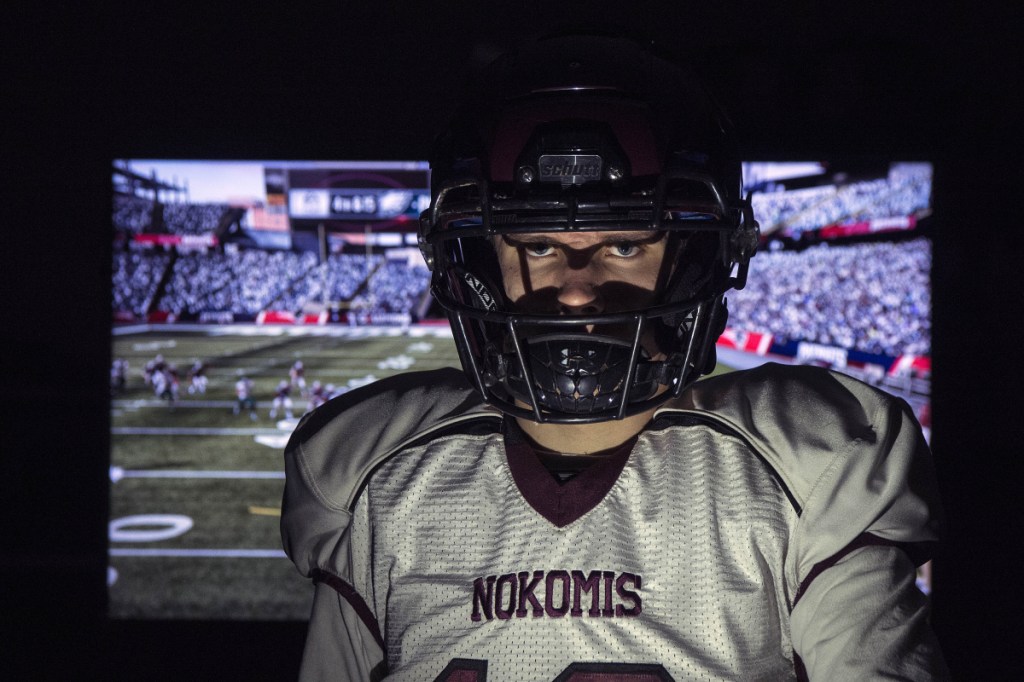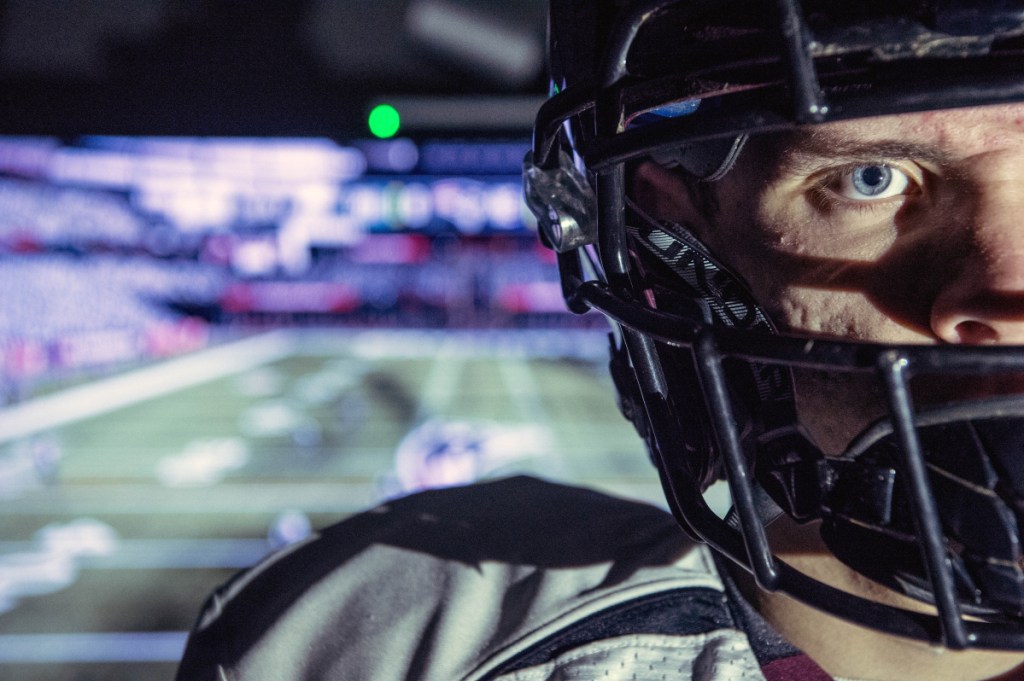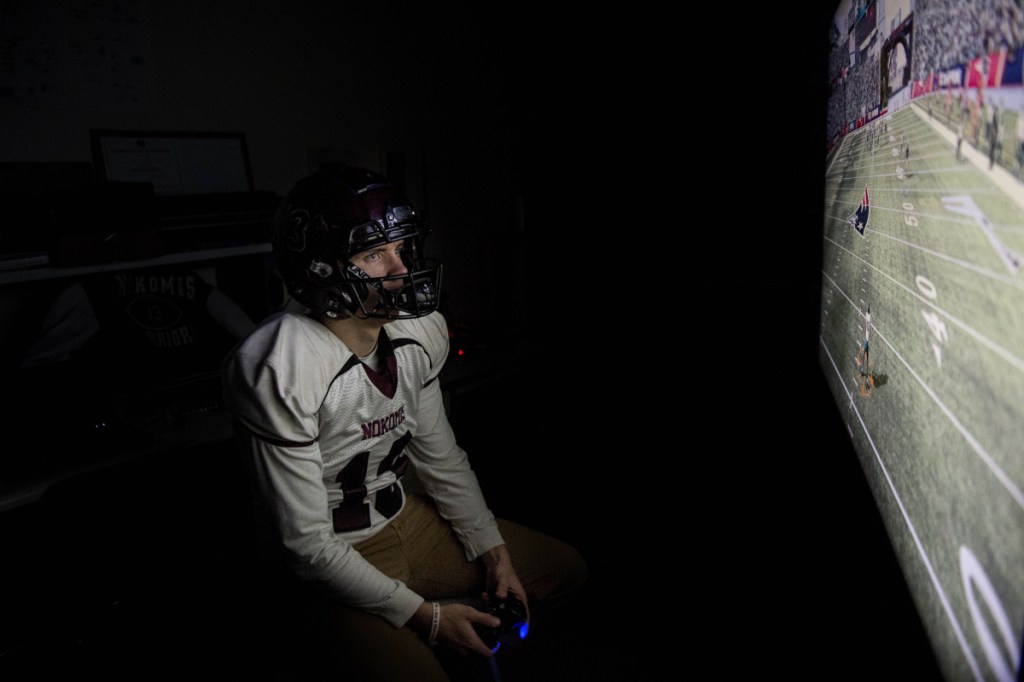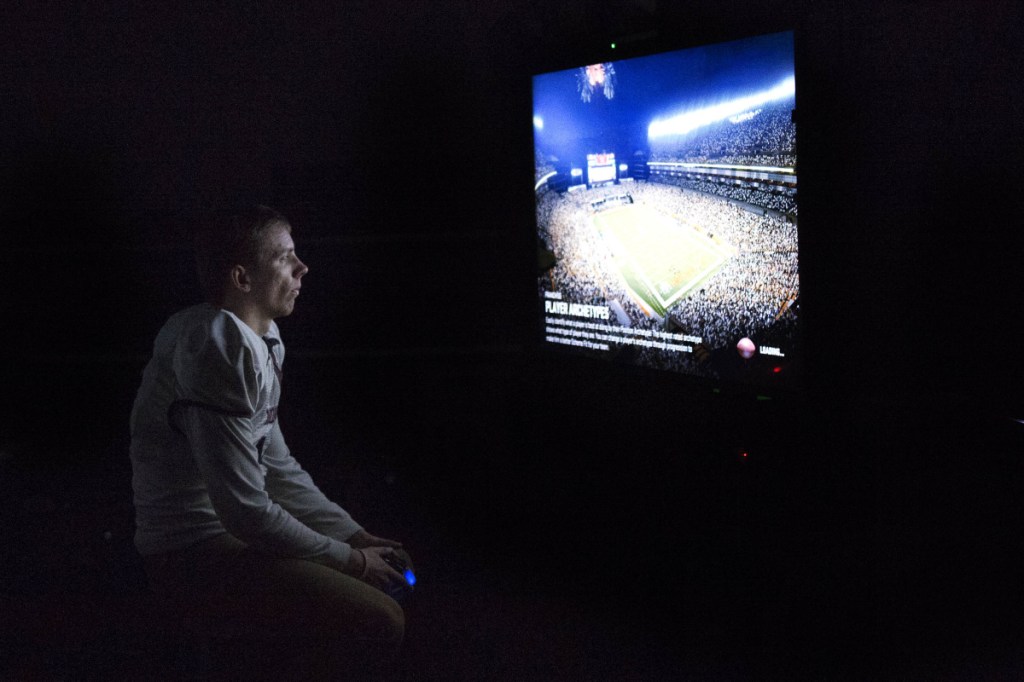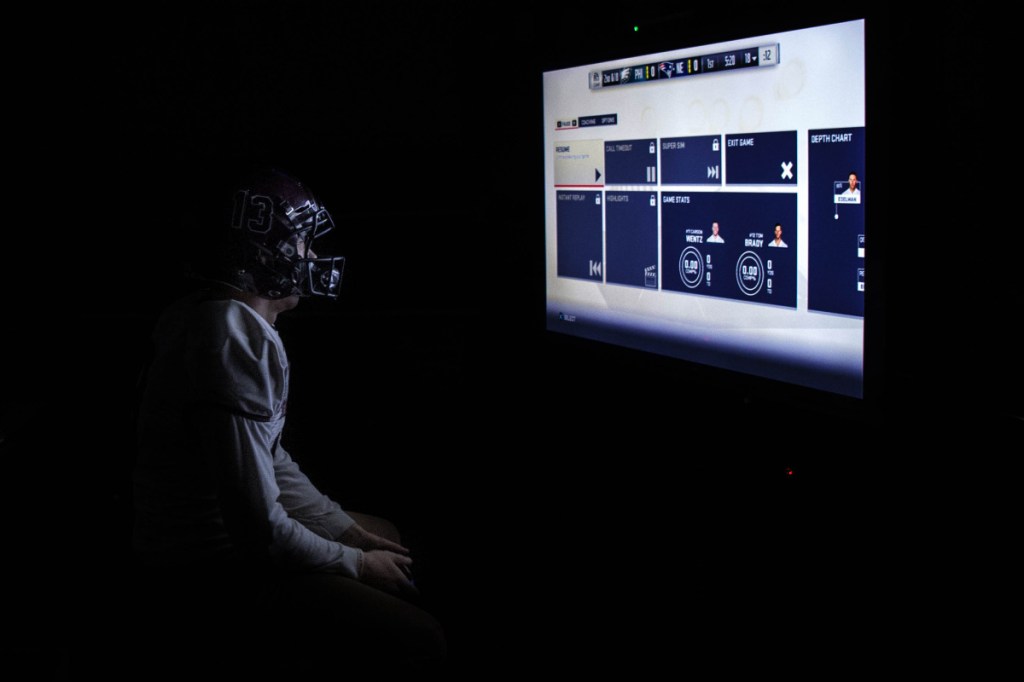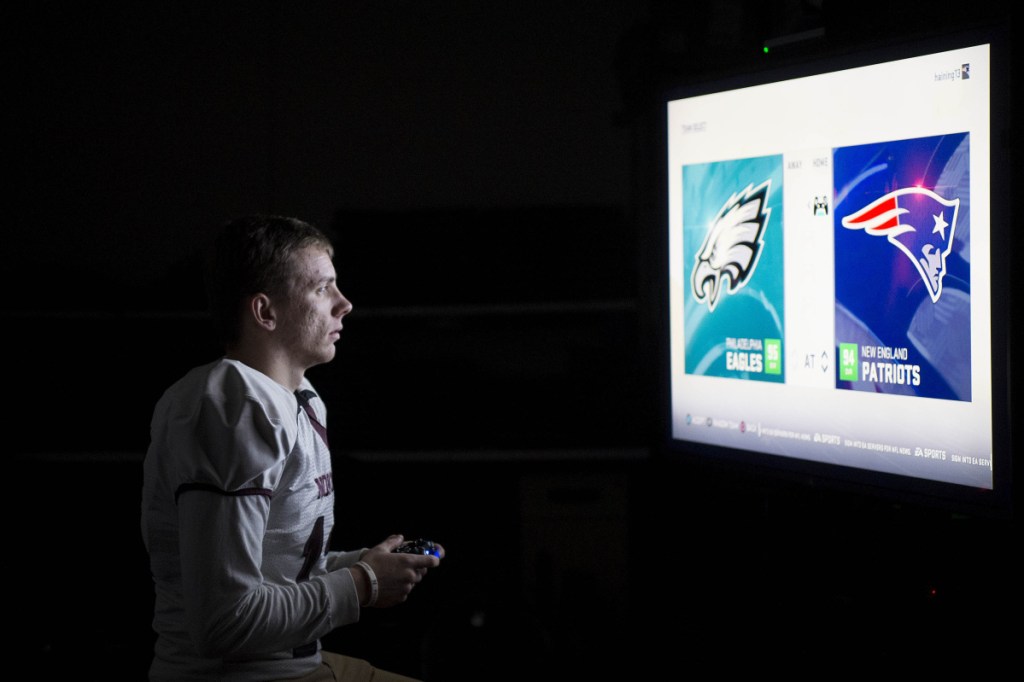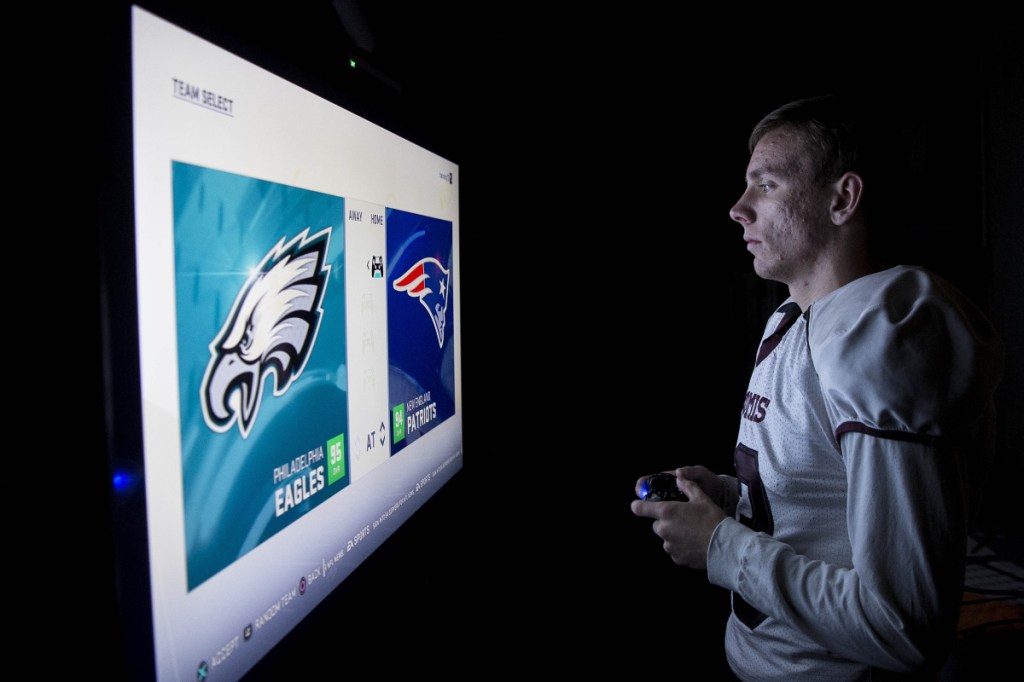The playoff rematch last season with Maine Central Institute was approaching, and Nokomis quarterback Andrew Haining was out of ideas.
Until he came up with an unorthodox way to troubleshoot the MCI defense.
“We really had no answer for their Cloud Cover 3 in Week 2 last year, so I knew we needed to figure something out,” he said. “So believe it or not, I came home and I repped Madden time and time again. Which plays are good to beat Cover 3 and where the windows often are.”

Nokomis quarterback Andrew Haining says some of the terminology in the Madden 19 video game is seen in real life on the field.
Nokomis lost, but not because of its offense. After being shut out 12-0 in the first game, Nokomis gave MCI all it could handle in a 33-24 defeat.
“You’d watch it on film and it was like the same exact thing,” said Haining, who threw for 192 yards and two scores in that 2017 game. “You’d see the window was the same on Madden as it was on the live game film.”
He’s not the only one making those observations. High school coaches and players alike say that Madden — the world’s best-selling football video game — can provide in helping players learn the language, concepts and strategy of the sport. Even those who play Madden for fun are exposed to plays that have applications in high school football.
They even go by the names their coaches would call them in real games and practices.
“The Xs and Os of it are very sound, it’s what we use,” said Nokomis coach and frequent football video player Jake Rogers, whose Warriors will play Fryeburg Academy in the Class C state title game Saturday.
“It teaches kids terminology, especially pass routes and coverages. And it’s a universal language, really. What’s a slant, what’s a curl route. Concepts like Smash. And on defense, it teaches man coverage, zone coverage, 4-3 defense versus 3-4 defense. They can see the inner workings of different schematics. It’s pretty cool.”
The plays in the video game are carried out on the practice field and in games, allowing players to see where cornerbacks, safeties, linebackers, receivers and running backs go when a certain play is called.
“If you’re running pass plays and stuff, and you watch your guy get open, you can almost copy how he did his route,” said Leavitt receiver and defensive back Keegan Melanson. “That helps.”
Playing Madden can give young football players a head start on learning the complicated lingo of the sport, and make for less of a learning curve at the high school level.
“Kids who play football video games, they definitely have an understanding of the terminology,” said Brunswick coach Dan Cooper, whose team will play Marshwood in the Class B state game Saturday. “And maybe even more of a passion for the game, because they’re competing playing video (games) too.”
LEARNING THE LANGUAGE
Cony coach B.L. Lippert begins installing plays during preseason practices. And each time, he hears the same thing.
“Every year, I’ll say something, whether it’s Smash or one of our concepts, and some kid will say ‘Oh, they have that on Madden,'” Lippert said. “Everyone in the world calls hitch-flag Smash. … That’s what it’s called on Madden. It’s the exact same play.”
By learning the Madden language, players learn the language of the game. Madden players learn the Smash concept. They learn the Stick concept, a three-man set where one receiver runs a hitch, another runs a horizontal stretch and the wide receiver runs a vertical stretch. They learn Robber coverage, where a safety comes up to either defend the run or defend passes over the middle.
Then they return to real life, go to practice or film study, and find the terms are the same.
“They don’t necessarily know it when they come in, but then when you put Smash on the board and you show it, they’re like ‘Oh, I’ve seen this before,'” said Leavitt coach Mike Hathaway. “The background knowledge is in there, and we can pull it back out by using some of the same verbiage.”
Hathaway’s son Wyatt, the Hornets’ quarterback, used Madden as a way to catch up on all the complicated jargon he heard his father using.
“I noticed that some of the stuff that they were saying, all of the coaches, I didn’t understand anything,” he said. “But then I’d go home, and if I were playing Madden, I could kind of see all the terms that they were using and what was really happening on the field. So I think it does kind of help, you can get ahead when you’re younger (with) your knowledge of the game compared to kids your age.”
Many coaches embrace it. Hathaway even uses plays in the Hornets’ playbook taken directly from the game.
“Drive is a term that we use a lot, which came directly out of the Madden game,” he said. “Sometimes we’ll let the kids choose what terms are for our no-huddle stuff, and a lot of the terms are things that they’ve seen in Madden. … It’s got to be things they remember, and they play a lot of video games, so they remember.”
A VISUAL TOOL
Oak Hill linebacker Ethan Richard, who called the Raiders’ plays on defense, offered a quick explanation for how he honed his acumen on the field.
“I spend a lot of time playing Madden and watching football, so I spend a lot of time understanding stuff,” he said. “Looking at coverages in Madden, looking at plays in Madden. It sounds stupid, but it really has a lot to do with the game.”
Given Madden’s nature as a simulator, kids playing it can get a sense not only for how a play is named, but how it is run as well.
“That’s something I have said to kids before. Go on there, put in Cover 3 on the defense, and see where people end up,” Lippert said. “The safety drops to the middle, the cornerbacks drop to the deep thirds. It’s a tool that you really could use.”

Nokomis quarterback Andrew Haining plays Madden Football 19 in Newport on Friday.
Madden also has a practice mode, in which players can set up an offense and defense with specific plays and run them over and over, looking for ways to combat a particular scheme, all while picking up clues on how to read a defense that can correlate to real action on the field.
“In Madden, the middle safety’s probably going to go to the same spot he does in real life,” Haining said. “Or the way they’re lined up, their stance. A Cover 3 stance is typically pretty obvious in the real game. Typically, you can see when it’s Cover 3 really quickly, and it’s the same thing in Madden.”
The benefits go both ways. Players can see how a play is supposed to be run, and coaches can gain an inspiration for drawing up or beating a play.
“I’ve been in Madden before and said ‘Well, hey, I see a formation.’ I watch my sons play and say ‘Well, what would I do out of that formation?'” said Madison coach Scott Franzose. “If you’re constantly coaching, you’re kind of spit-balling things.”
NO SUBSTITUTE FOR FILM
Franzose sees the good in Madden as a learning tool. He also sees the caveats.
“(Players will) pipe in and say ‘Oh yeah, I saw that on Madden,'” Franzose said. “I’ll say ‘OK, that’s great. Explain it to me.’ … Are they truly understanding how it fits on a three-dimensional plane on the football field?”
As supportive as coaches and players are of the game, they know it’s hardly a replacement for practice and film study. The game can be paused, moves at a slower pace that doesn’t replicate the chaotic nature of a high school game, and doesn’t have the benefit of someone to explain the uses behind a concept or scheme.
“I don’t know if I’d say it’s on par with film,” Haining said. “You get the idea of the concepts, but I don’t know if there’s a substitute for film.”
Instead, the key, they’ll say, is to use it as a side device. Use it to build an interest and understanding of the game, and then to hone some finer points.
“I think any absorption of the game is great,” Rogers said. “If they’re watching it, there’s a good chance they’re going to love the game. A video game’s no different than watching it, and I think it’s more interactive.
“I think any competition is great, and video games do that. I think they’re helpful, I truly do.”
Drew Bonifant — 621-5638
dbonifant@centralmaine.com
Twitter: @dbonifantMTM
Send questions/comments to the editors.


